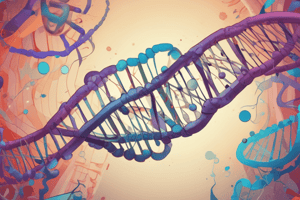Podcast
Questions and Answers
What describes the directionality of the two DNA strands in a double helix?
What describes the directionality of the two DNA strands in a double helix?
- Both strands run from 5' to 3'
- One strand runs from 5' to 3' while the other runs from 5' to 5'
- Both strands run from 3' to 3'
- One strand runs from 5' to 3' while the other runs from 3' to 5' (correct)
What process describes the flow of genetic information from DNA to RNA to protein?
What process describes the flow of genetic information from DNA to RNA to protein?
- Central dogma (correct)
- Transcription
- Translation
- Replication
What type of replication occurs when new strands of DNA are formed with one parental strand and one newly synthesized strand?
What type of replication occurs when new strands of DNA are formed with one parental strand and one newly synthesized strand?
- Semiconservative replication (correct)
- Continuous replication
- Dispersive replication
- Conservative replication
Which of the following statements about DNA polymerase is correct?
Which of the following statements about DNA polymerase is correct?
What are the small fragments formed during discontinuous DNA replication called?
What are the small fragments formed during discontinuous DNA replication called?
What holds the two chains of DNA together?
What holds the two chains of DNA together?
Which groups are part of the amino acid structure?
Which groups are part of the amino acid structure?
How many different amino acids are used in protein synthesis?
How many different amino acids are used in protein synthesis?
What role does DNA helicase play during DNA replication?
What role does DNA helicase play during DNA replication?
In which direction can DNA polymerase synthesize new DNA strands?
In which direction can DNA polymerase synthesize new DNA strands?
What is the function of DNA ligase during DNA replication?
What is the function of DNA ligase during DNA replication?
What best describes the replication of DNA?
What best describes the replication of DNA?
What is primarily formed along the lagging template strand during DNA replication?
What is primarily formed along the lagging template strand during DNA replication?
What is the primary function of proteins produced from genes?
What is the primary function of proteins produced from genes?
Which statement about DNA structure is accurate?
Which statement about DNA structure is accurate?
What role does heredity play in genetics?
What role does heredity play in genetics?
Which type of biological unit is a nucleotide?
Which type of biological unit is a nucleotide?
During the replication of DNA, what does the term 'antiparallel' refer to?
During the replication of DNA, what does the term 'antiparallel' refer to?
What do genes consist of?
What do genes consist of?
What is the significance of genetic variation?
What is the significance of genetic variation?
Which of the following is NOT a nitrogen base found in DNA?
Which of the following is NOT a nitrogen base found in DNA?
Flashcards are hidden until you start studying
Study Notes
Introduction to Genetics
- Genetics is the study of genes, genetic variation, and heredity in living organisms.
- Genetics studies biologically inherited traits, including traits influenced by the environment.
- Heredity is the passing on of traits from parents to offspring through reproduction.
- Variations between individuals can accumulate and cause species to evolve.
DNA: Our Genetic Material
- A gene is a section of DNA that contains the instructions to produce specific molecules in the body, usually proteins.
- These proteins control how our body grows and works.
- Proteins are responsible for many characteristics, such as eye color, blood type, and height.
DNA Structure & the Central Dogma
- DNA is a nucleic acid composed of nucleotides.
- A nucleotide is a monomer consisting of deoxyribose sugar, a phosphate group, and a nitrogenous base (Adenine (A), Cytosine (C), Guanine (G), or Thymine (T)).
- Two antiparallel polynucleotide strands form DNA.
- The strands run parallel but in opposite directions (5' -> 3' and 3' -> 5').
- The strands are held together by hydrogen bonds between their bases, known as base pairing.
The Central Dogma of Biology
- The central dogma describes the flow of genetic information from DNA to RNA (transcription) to protein (translation).
- DNA replication is a semiconservative process, meaning each new DNA molecule contains one original strand and one newly synthesized strand.
DNA Replication: Initiation & Elongation
- DNA replication occurs in two main steps: initiation and elongation.
- During initiation, the DNA double helix unwinds and separates.
- During elongation, new DNA strands are synthesized along each template strand using DNA polymerase.
DNA Replication: Key Facts
- DNA polymerase can only synthesize DNA in the 5' to 3' direction.
- Continuous replication occurs on the leading strand, which is synthesized continuously towards the replication fork.
- Discontinuous replication occurs on the lagging strand, which is synthesized in fragments called Okazaki fragments.
- DNA ligase joins the Okazaki fragments together.
- DNA polymerase can proofread the new strands of DNA to eliminate mutations.
DNA Repair
- If DNA is physically damaged or broken, DNA ligase can function as a DNA repair enzyme.
- DNA ligase links the fragments back together.
Studying That Suits You
Use AI to generate personalized quizzes and flashcards to suit your learning preferences.




